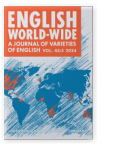Vol. 45:2 (2024) ► pp.155–195
Revisiting the aspectual BUSY in (South African) English
This paper investigates the so-called South African English busy progressive (for example, I’m busy working). Linguistic literature on South African English (SAfE) often states that this construction is a typical feature of this variety of English. The use and the frequency of this construction is mostly attributed to the influence of the Afrikaans [BUSYPROG XCOMP VINF] construction, as in Ek is besig om te werk (‘I am working’). The aim of this paper is twofold: Firstly, it critically evaluates some of the claims that have been made about the so-called “SAfE busy progressive” and, secondly, it uses a corpus- and usage-based approach that employs a greater assortment of available corpus data from SAfE and other English varieties, as well as available information on the Afrikaans and Dutch progressives, to explore the possibility of new insights into the use of busy in English aspectual constructions.
Article outline
- 1.Introduction
- 2.Methodology
- 3.The [BUSY V -ingPROG] construction
- 3.1Is [BUSY V‑ingPROG] a typical and prominent lexico-grammatical feature of SAfE?
- 3.1.1The frequency of [BUSY V‑ingPROG] in SAfE and other English varieties
- 3.1.2The main verb collocations of [BUSY V‑ingPROG]
- 3.2Can [BUSY V‑ingPROG] be attributed to language contact with Afrikaans?
- 3.3Is busy an unnecessary or redundant progressive marker in the SAfE progressive construction?
- 3.3.1Aktionsart and transitivity
- 3.3.2Semantic roles of the subject
- 3.4Is the [BUSY V -ingPROG] construction in South African English similar to the Afrikaans and Dutch [BUSYPROG XCOMP VINF]?
- 3.1Is [BUSY V‑ingPROG] a typical and prominent lexico-grammatical feature of SAfE?
- 4.[BUSYPROG XCOMP VINF]
- 4.1[BUSYPROG XCOMP VINF] in corpora of contemporary English
- 4.2[BUSYPROG XCOMP VINF] in corpora of historical English
- 5.Conclusion
- Acknowledgements
- Notes
-
Sources -
References
